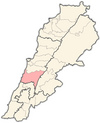Deir al-Qamar
Lady Hester Stanhope visiting Deir al-Qamar in 1812 wrote “I have traveled for nine hours together & never found a place to pitch a tent, except near one Village.The Vineyards are like stair cases, & every little flat place stuffed with mulberry trees for the silkworms, the roads are horrible, & the people savage & extraordinary, the women wearing a great tin trumpet on their heads & a veil suspended upon it, & seemingly very proud of these frightful horns.”[3] It was the first village in Lebanon to have a municipality in 1864, and it is the birthplace of many well known personalities, such as artists, writers, and politicians.[4] Napoleon III sent a French contingent to rebuild it, recalling France ancient role as protector of the Christians in the Ottoman Empire as established by a treaty in 1523.A census undertaken in Deir al-Qamar by the Ottomans during the reign of Fakhr-al-Din II's father, Qorqmaz bin-Maan, counted 156 men, all Druze.[13] According to Pierre-Marie Martin, writing in 1870, the Druze venerated the church even more than the Maronites, often traveling long distances to pray to the Virgin Mary in their own way and "witnessing numerous miracles".[14] Historian Glenn Bowman further highlights that in the early nineteenth century, Druze leaders would seek the Virgin Mary's favor at Saidet et Tallé before going into battle.The first record of a Jewish community in Deir al-Qamar in modern times is found in the writings of Rabbi Joseph Soffer, who visited Lebanon in 1759.All in all, these sources suggest that under the rule of Yusuf Shihab and Zahir al-Umar, a Jewish community existed, complete with its own beth din and synagogue.[17] Rabbi Joseph Schwartz provides additional insights into the Jewish community of Deir al-Qamar, estimating it consisted of around 80 householders, primarily engaged in trade.Thirty-five armed Jews responded, arriving in Safed to aid in clearing the debris, retrieving the deceased for burial, and potentially providing material assistance to those impacted by the disaster.



CountryLebanonGovernorateMount Lebanon GovernorateDistrictChouf DistrictTime zoneDialing codeArabicromanizedBeirutBeit ed-DineMoussa CastleTeutonic OrderEmirate of Mount LebanonFakhreddine MosqueFakhreddine II PalaceYusuf ShihabsynagogueLady Hester StanhopeQaim-MaqamateBaakleencivil warNapoleon IIIFakhr-al-Din IIMaronitesMelkitesBechara Al KhouryGeorges Dib NehmeChristiansMaronite CatholicsGreek CatholicsSaydet El TalleChurch of Saidet et TalléDeir el QamarSaracensVirgin MarySaidet et TalléJewishTorah scrollResponsa literatureZahir al-Umarbeth din1837 Safed earthquakeblood libel1860 civil conflict in Mount LebanonWax MuseumMount LebanonChristianDeir el Qamar SynagogueCollinsBen-Zvi, ItzhakStrehlke, E.BeitedineAin W ZainAin ZhaltaAinbalAmmatourBaadarâneBakaataBaroukBatlounBourjein et MarjiyatDahr El MagharaDamourDarayaDibbiyehEl FoûâraHaret JandalGharifeJahliehJdaidehKahlouniyeKfarfakoudKfar NabrakhMazraat el-ChoufMazraat el DaherMoukhtaraNa'amehRmeilehSerjbelShheemSymkaniehZaarouriehBeiteddine PalaceFakhredine PalaceFakhredine MosqueAl Shouf Cedar Nature Reserve
